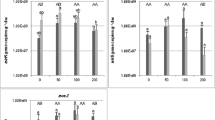Summary
In high-alpine soils the maximum temperature is low even during the growing season, and hence mineralisation of nutrients is reduced. The aim of this study was to investigate what sources of nitrogen and phosphorus are available for vascular plants in the alpine nival zone to support growth. Using acetylene reduction assays levels of nitrogenase activity were assessed in sealed pots containing nival zone soil and plants at an altitude above 3000 m, and in bacterial isolates of soil and rhizosphere in the laboratory. Nitrogenase activity could not be detected in bacterial isolates or in the soil containing no plants. Small quantities of ethylen (<87 nmol·h-1 per pot) were detected in pots with Cerastium uniflorum and Poa laxa. This activity must be attributable to rhizosphere bacteria since no evidence for the presence of cyanobacteria could be obtained.
Other sources of nitrogen for the plants were detected in the form of ammonium and nitrate in soil water and in snow melt water. These solutions also contained extractable phosphorus in quantities normally considered to be sufficient for growth. Analyses of the internal concentration of nitrogen and phosphorus also suggested that these elements were present in adequate amounts in these plants. It was considered that soil and snow melt water together may provide sufficient nitrogen and phosphorus to support the extremely small annual growth increment of nival zone plants.
Similar content being viewed by others
References
Alexander V, Billington M, Schell DM (1978) Nitrogen fixation in Arctic and Alpine Tundra. In: LL Tieszen (ed), Ecological studies Vol 29, Vegetation and production ecology of an Alaskan Arctic Tundra. Springer. Berlin-Heidelberg-New York pp 539–558
Allen SE (1974) Chemical analysis of ecological materials. Blackwell, Oxford-London-Edinburgh-Melbourne
Blasco JA, Jordan DC (1976) Nitrogen fixation in the muskeg ecosystem of the James Bay Lowlands, Northern Ontario. Can J Microbiol 22:897–907
Bremner JM (1960) Determination of nitrogen in soil by the Kjeldahl method. J Agr Sci 55:1–23
Brewer PG, Riley JP (1965) The automatic determination of nitrate in sea water. Deep Sea Res 12:765–772
Crittenden PD (1983) The role of lichens in the nitrogen economy of sub-arctic woodland: N losses from the N-fixing lichens Stereocaulon paschale during rainfall. In: Lee JA, McNeill S, Rorison IH (eds), Nitrogen as an ecological factor. Blackwell, Oxford-London-Edinburgh-Melbourne, in press
Franz H (1979) Ökologie der Hochgebirge. Ulmer, Stuttgart
Gökçeoĝlu M, Rehder H (1977) Nutrient turnover studies in alpine ecosystems. III. Communities of lower altitudes dominated by Carex sempervirens Vill. and Carex ferruginea Scop. Oecologia (Berlin) 28:317–331
Graham JH, Leonard RT, Menge JA (1981) Membrane-mediated decrease in root exudation responsible for phosphorus inhibition of vesicular-arbuscular mycorrhiza formation. Plant Physiol 68:548–552
Haapala K (1972) Sadeveden laatu Suomessa vuonna 1971. National Board of Waters, Helsinki, Report 26
Haselwandter K, Read DJ (1980) Fungal associations of roots of dominant and sub-dominant plants in high-alpine vegetation systems with special reference to mycorrhiza. Oecologia (Berlin) 45:57–62
Jackson ML (1958) Soil chemical analysis. Prentice-Hall, London
Johannessen M, Henriksen A (1978) Chemistry of snow melt water: changes in concentration during melting. Water Resources Res 14:615–619
Jordan DC, McNicol PJ, Marshall MR (1978) Biological nitrogen fixation in the terrestrial environment of a high Arctic ecosystem (Truelove Lowland, Devon Island, N.W.T.). Can J Microbiol 24:643–649
Kallio P, Veum AK (1975) Analysis of precipitation at Fennoscandian Tundra sites. In: FE Wielgolaski (ed), Ecological studies Vol 16, Fennonscandian Tundra ecosystem Part I: Plants and microorganisms. Springer, Berlin Heidelberg New York pp 333–338
Kasza H (1979) Wody opadów atmosferyznych jako źródło składników biogennych dla zbiornika goczałkowickiego. Acta Hydrobiol 21:279–289
Kol E, Eurola S (1973) Red snow in the Kilpisjärvi region, North Finland. Astarte 6:75–86
Labroue L, Carles J (1977) Le cycle de l'azote dans les sols alpins du Pic du Midi de Bigorre (Hautes-Pyrénées). Oecol Plant 12:55–77
Larcher W (1980) Klimastreß im Gebirge — Adaptationstraining und Selektionsfilter für Pflanzen. Rheinisch-Westfälische Akademie der Wissenschaften 291:49–80
Larcher W (1983) Ökophysiologische Konstitutionseigenschaften von Gebirgspflanzen. Ber dtsch bot Ges, in press
Michelsen OB (1957) Photometric determination of phosphorus as molybdovanadophosphoric acid. Anal Chem 29:60–62
Moser W (1970) Microclimate and photosynthesis in the nival zone of the Alps. IBP Tundra Biome Working Meeting Kevo, Finland 1970:22–33
Moser W (1973) Licht, Temperature and Photosynthese an der Station “Hoher Nebelkogel” (3184 m). In: Ellenberg H (ed), Ökosystemforschung. Springer, Berlin Heidelberg New York pp 203–223
Moser W, Brzoska W, Zachhuber K, Larcher W (1977) Ergebnisse des IBP-Projekts “Hoher Nebelkogel 3184 m”. Sitzungsber Österr Akad Wiss, Math.-naturw Kl, Abt I, 184:159–171
Murphy J, Riley JP (1958) A modified single-solution method for determination of soluble phosphate in seawater. J Mar Biol Ass UK 7:9–14
Norris JR (1959) The isolation and identification of azotobacters. Lab Pract 8:239
Pechlaner R, Sossau C (1982) Limnologische Untersuchung Traunsee/Traun (Zusammenfassender Bericht). Ber Limnol Unt Traunsee/Traun 13:1–235
Read DJ, Haselwandter K (1981) Observations on the mycorrhizal status of some alpine plant communities. New Phytol 88:341–352
Rehder H (1976a) Nutrient turnover studies in alpine ecosystems. I. Phytomass and nutrient relations in four mat communities of the Northern Calcareous Alps. Oecologia (Berlin) 22:411–423
Rehder H (1976b) Nutrient turnover studies in alpine ecosystems. II. Phytomass and nutrient relations in the Caricetum firmae. Oecologia (Berlin) 23:49–62
Rehder H, Schäfer A (1978) Nutrient turnover studies in alpine ecosystems. IV. Communities of the Central Alps and comparative survey. Oecologia (Berlin) 34:309–327
Tosca C, Labroue L (1981) Le cycle de l'azote dans les milieux supra-forestiers des Pyrénées Centrales: contribution à l'évaluation des gains. Acta Oecologica (Oecol Plant) 2:41–52
Truog E (1930) The determination of the readily available phosphorus of soils. J Am Soc Agron 22:874–882
Wagner R (1969) Neue Aspekte zur Stickstoffanalytik in der Wasserchemie. Vom Wasser 36:263–318
Author information
Authors and Affiliations
Rights and permissions
About this article
Cite this article
Haselwandter, K., Hofmann, A., Holzmann, H.P. et al. Availability of nitrogen and phosphorus in the nival zone of the Alps. Oecologia 57, 266–269 (1983). https://doi.org/10.1007/BF00379589
Received:
Issue Date:
DOI: https://doi.org/10.1007/BF00379589



